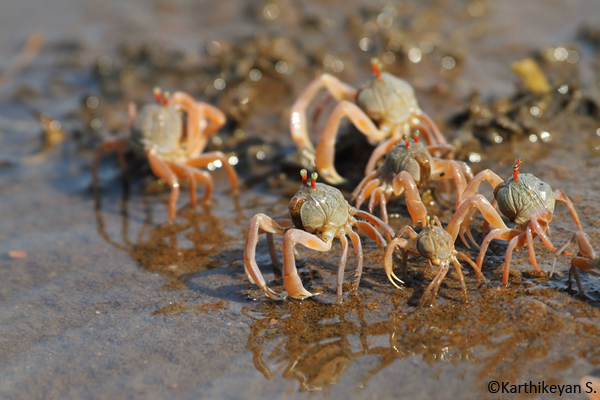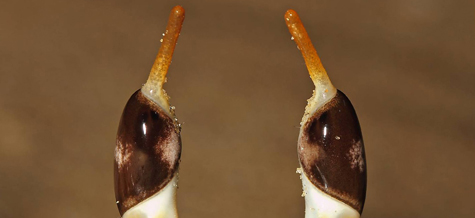A walk along the beach is something most people would enjoy. When we see crabs trying to run away from our path, often the child in us comes to the fore and we run about chasing them! It was during my first visit to Devbagh, Karwar that I was taken by surprise by the beauty of the few crabs that I saw. Even as I arrived at the jetty, I saw a large crab moving about on the rocks. It had stunning red legs. As I approached it, it disappeared under the rocks. On the same trip I also chanced upon my first fiddler crabs. Thus began my tryst with crabs.
Over the years, during the many visits to Devbagh, I have spent considerable amount of time looking for crabs both on the shore and also in the mangroves around Devbagh. I have thoroughly enjoyed waiting for them to come out of their burrows, watching them at work, and in the process I have also managed to photograph a good number of them. It was at this juncture that I happened to meet Ms. Pradnya Bandekar who readily agreed to help in the identification of the crabs from the photographs. I would like to thank her for all the help she extended in this process.
Here is an effort to show case some crabs of Devbagh, Karwar.
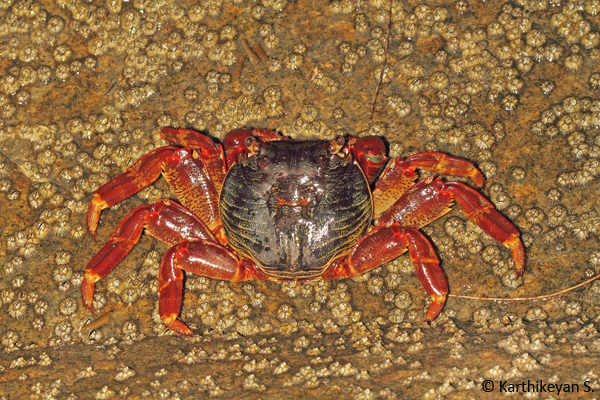 Family Grapsidae – Grapsus albolineatus
Family Grapsidae – Grapsus albolineatus
This crab is best seen on a rocky beach. The red legs of the crab, along with the patterned carapace and colourful pincers are quite attractive. When they sense disturbance, these crabs tend to go under the rocks and boulders. They are known to occur all the way from the east coast of Africa to Australia. In India, they can be seen along the east and west coast and on the Andaman and Nicobar Islands.
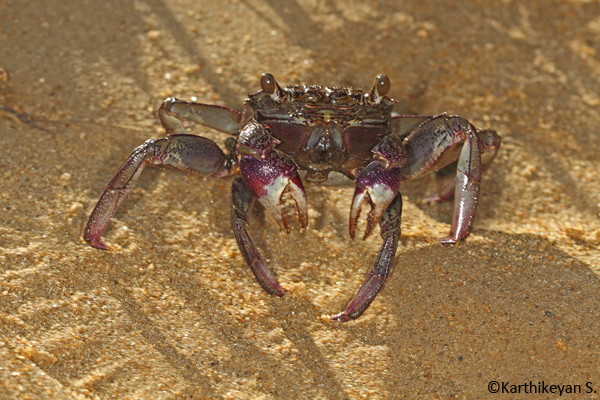 Family Grapsidae – Metapograpsus latifrons – Purple Crab
Family Grapsidae – Metapograpsus latifrons – Purple Crab
The Purple Crab is not a particularly large species. These crabs can be seen on rocky shores. However, the one that I sighted was near the roots of mangroves during low tide. They are known to be nocturnal, hiding in holes and crevices during the day. The carapace has yellowish markings; the purple colour of the pincers is very noticeable. Though their main food seems to be algae which they scrape off rocks with their pincers, they will scavenge on any edible matter that they chance upon.
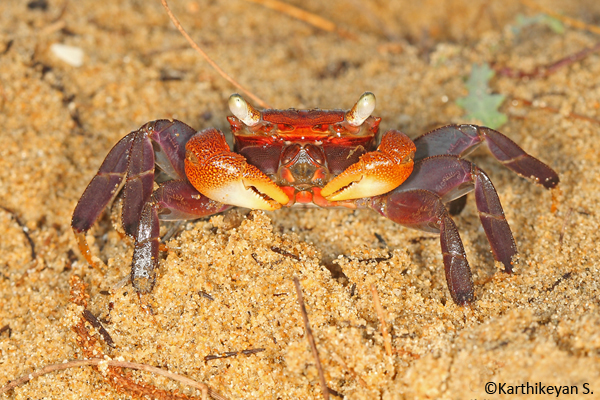
Family Grapsidae – Sesarma quadratum
This little crab is very colourful. The orange on the front of the carapace and the pincers stand out on an otherwise dark purple coloured crab. It is known to be common among the prop roots of mangroves. I saw this individual among prop roots during low tide.
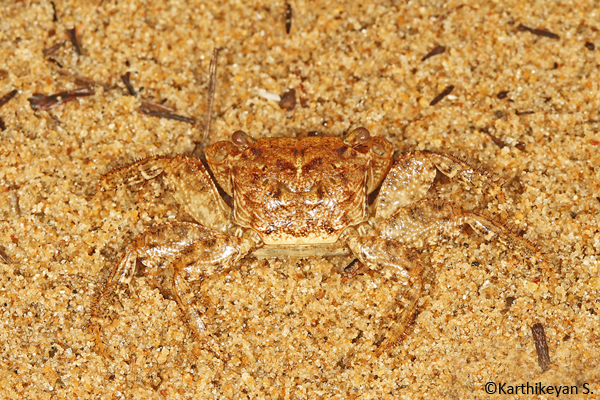
Family Grapsidae – Sesarma sp.
Like the previous two species this Sesarmid is also small – about an inch across. However, its the colouration helped the crab blend beautifully with the background.
Family Ocypodidae – Dotilla myctiroides – Soldier Crabs
Watching the Soldier Crabs can be a very interesting experience! During low tide they come out in large numbers and set about feeding. This is also the time when there is plenty of interaction. Frequent altercations between individuals can also be witnessed. All in all, the Soldier Crabs make good subjects to sit back and watch while on the beach. Click here to read more.
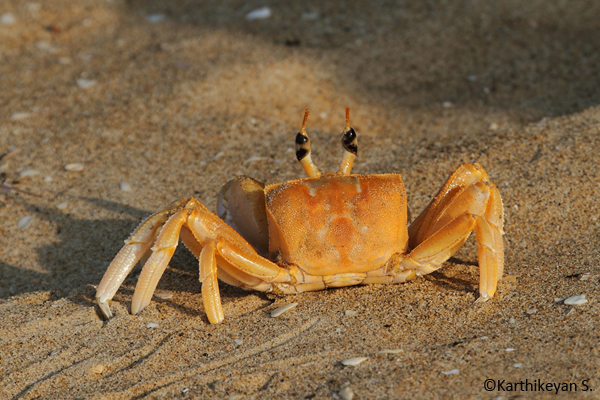 Family Ocypodidae – Ocypode ceratopthalmus – Ghost Crab
Family Ocypodidae – Ocypode ceratopthalmus – Ghost Crab
These Ghost Crabs are known to change colour. They can be yellow (as in the picture above), they could be shades of brown or grey. Their young are translucent and their colours match the sandy substrate camouflaging them in their habitat.
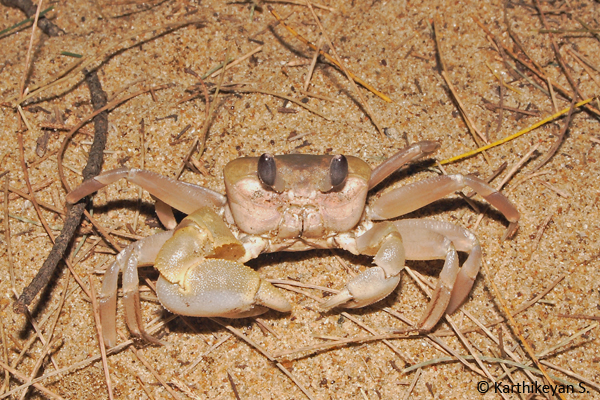 Family Ocypodidae – Ocypode cordimanus
Family Ocypodidae – Ocypode cordimanus
Like O. ceratopthalmus, this species also enjoys a wide distribution. Both these species can be seen occurring alongside each other on the beaches between sunset and sunrise. This species is told apart easily by the absence of the ‘horns’ on the eyes. They occur in the inter-tidal zone, where, when disturbed they run into their deep burrows. Sometimes, they run into the surf only to disappear temporarily in the incoming wave!
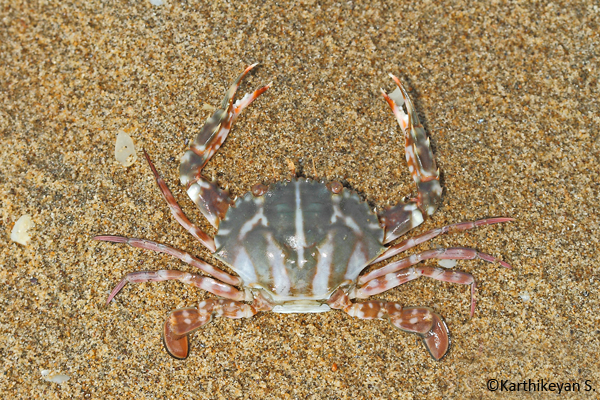 Family Portunidae – Charybdis cruciata
Family Portunidae – Charybdis cruciata
Charybdis cruciata is also known as C. feriata. Like other crabs discussed above, this is also found from the east coast of Africa all the way up to Australia. In India itself, it is found on both the east and the west coasts and Andaman and Nicobar Islands. These swimming crabs are prettily marked. They can be seen inhabiting rocky areas as well as sandy and muddy areas.
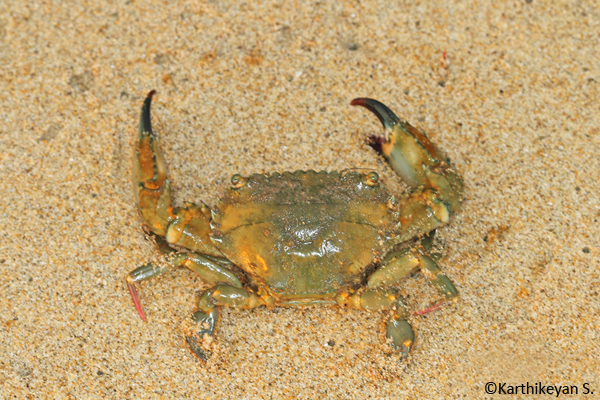 Family Portunidae – Thalamita crenata – Crenate Swimming Crab
Family Portunidae – Thalamita crenata – Crenate Swimming Crab
The colour of these crabs is very variable. However, individuals with a greenish or brownish shell with some yellow are most frequently met with. Though most members of this group are active during the night, they do venture out during day time and this is particularly true of this species. This species also enjoys a wide distribution – from Madagasar to Hawaii where they inhabit mudflats, sandy beaches and mangroves. As in the Mud Crab of the same family, the Crenate Swimming Crab has the last pair of legs flattened into a paddle and is used for swimming. This, similar to the Mud Crab, is also aggressive and will not hesitate to use its claws in self-defence.
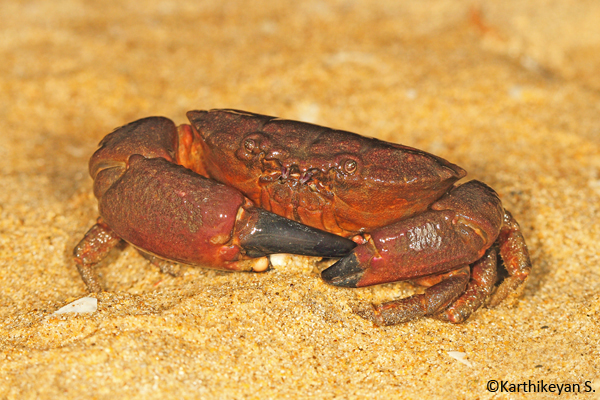 Family Xanthidae – Atergatis subdentatus – Red Reef Crab
Family Xanthidae – Atergatis subdentatus – Red Reef Crab
The Red Reef Crab Atergatis subdentatus has a squat appearance. The uniform reddish brown colour and robust pincers can help in identifying these crabs. Around Karwar, these crabs can be seen on rocky beaches. As a species it is distributed from the Lakshadweep Islands and Gulf of Mannar to Singapore, Japan and Taiwan.
Crabs are a very important and easily noticeable component of the coastal and mangrove ecosystems. They have adapted to the tidal actions and also the varying salinity that is so typical of delta areas. They are considered to be the most predominant species particularly in the mangrove forests. This also could be because many crabs use the mangroves for their very survival. They feed on the leaf litter and other organic matter. Thus play an important role in recycling of nutrients. Their behaviour of digging into the sand helps better aeration of the soil.
As should be expected, crabs of the coasts and mangroves use an array of specific habitats. While some use the spaces between prop roots of mangrove trees, others use the rocky shores; some use mud banks and mud flats while others, the intertidal zone. Some also use the habitat created by streams and channels that make their way to the sea while others, the zone between the low and high tides.
Sea eagles, kites, waders, etc. among birds and small mammals like mongooses and shrews have crabs as part of their diet. All of these co-exist in the coastal habitat making for interesting observations and also for interesting action to look forward to while on the beach.
A variety of human activities threatens the survival of the coasts and associated habitats on which the crabs are dependent. So, while we let our curiosity and the child in us take over, let us also be cautious, responsible and sensitive about what we do when we spend time on the beach. Let us not forget that there are others creatures that play on the beach and also call it their home!
